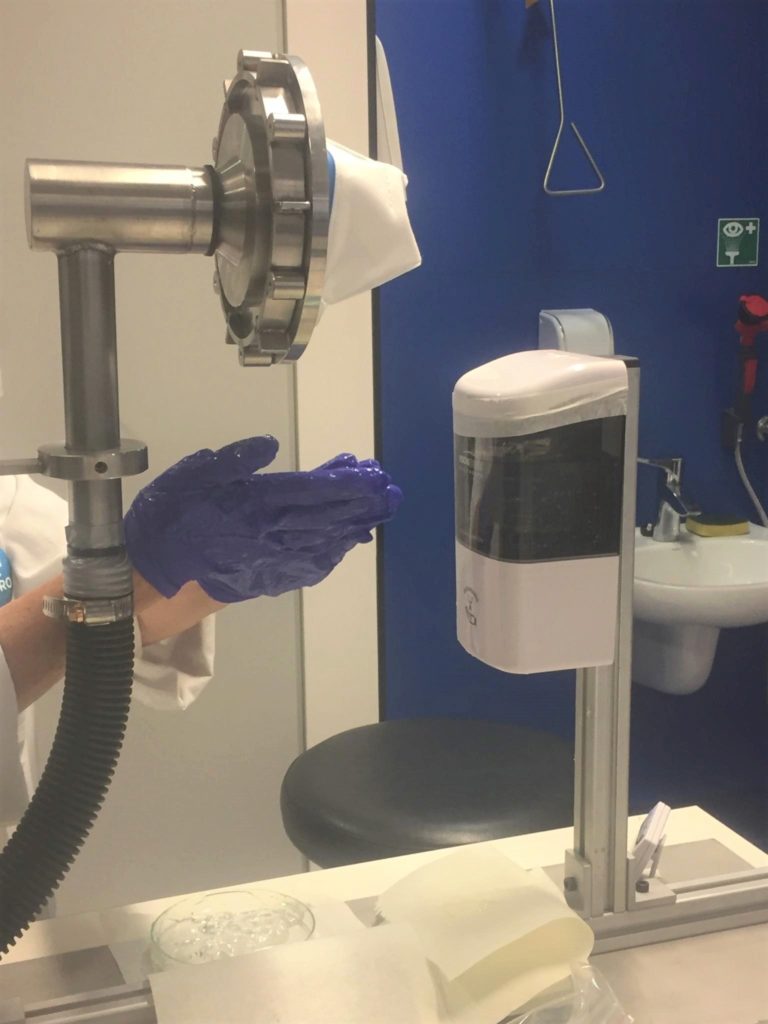Since the beginning of the COVID-19 pandemic, most of us use two items on a regular basis. The first is hand sanitising products and the second is face masks.
In many cases these two items are our first line of defence against the virus. The only thing standing between us and it. But what if one of these two items had the potential to counteract the other so that it no longer worked?
That's exactly the situation our researchers investigated in a recent study. Their research looked at the effects of alcohol-based sanitiser vapours on respirator filtration systems, specifically face masks.
Being filtration experts, they understood the technology behind the most commonly used disposable face masks, including the (K)N95 and P2 rated masks, relies on electrostatic charge.
A charge against COVID
Electrostatic charge is the result of friction between two surfaces. It's what causes the ‘zap’ you sometimes get when touching someone or something. It also features in the famous rub-your-head-with-a-balloon-to-make-your-hair-stand-on-end party trick.
But did you know that this important mechanism is also embedded into your disposable face mask? It works by using an electrostatic field to attract pathogenic particles in the air. Thus, making them hit the surface of the mask’s web of fibres. A trapping mechanism (known as van der Waals forces) then works to capture the particles, trapping them like a sticky spider web.
This mechanism, however, can be weakened by fumes from the alcohols contained in many common sanitising products, like ethanol and isopropanol. Concentrated vapours from these products remove the electrostatic charge.
This kind of event could be disastrous during real-world pandemic mitigation practices. The disruption could possibly allow pathogens like COVID-19 to pass straight through a face mask and reach the wearer.

Investigating mask care in real-world scenarios
The pandemic has seen an increased use of both face masks and alcohol-based hand sanitising products. There has also been an increase in sanitising of surface areas such as work benches, restaurant tables and hospital surfaces.
Our researchers hypothesised this increased combination of mask and sanitiser might be problematic. But until now, this was only a theory. It hadn't been scientifically tested.
So, they set out to conduct what we believe to be a world-first study. They looked closely at the real-world impact of vapours from hand sanitisers and alcohol-based cleaning solutions on the performance of single-use face masks.
The same team that established Australia’s first certified testing facility[Link will open in a new window] for single-use face masks in response to COVID-19 worked with our Data61 team to analyse their findings. They examined four different strategies that people might use to mitigate exposure to the COVID-19 virus. These included:
- The use of hand sanitisers while wearing a mask
- Cleaning of table surfaces while wearing a mask
- Sanitisation of masks by spraying with alcohol-based solutions
- Exposing masks to concentrated alcohol-based vapours
Should we be worried?
Surprisingly, the findings were not too bad.
The study found disposable respirator masks such as the KN95 and P2 were able to retain their effectiveness after being exposed to a certain degree of alcoholic vapours. After either four hours of continuous exposure to alcoholic sanitiser vapours or one direct spray of sanitiser, the masks still removed 98 per cent of all particles in the breathed in air. Any further exposure had the potential for more serious degradation.
After exposure to a high concentration of alcoholic vapours, this changed. The masks became so compromised they no longer offered protection. This high concentration is quite extreme. A real-life scenario might be sealing your mask in a plastic container with an alcohol-based sanitiser product.
Some people think that exposing their disposable mask to sanitiser overnight will squeeze an extra day of use out it. In fact, it will have the opposite effect by destroying the mask’s charge and hence its functionality. It is always best to use your mask as per the manufacturer’s instructions. And remember that single-use masks are just that.
Breathing easy
Shortages of masks and personal protective equipment have been common throughout the pandemic. If people are going to sanitise and reuse masks in situations like this, we need to understand how the masks will react. Our team suggests that manufacturers should assess the specific effects of different exposures of respirator masks to alcoholic vapours before use.
Literature on this issue painted a somewhat confusing and ambiguous picture about the effect of sanitiser fumes on filtration material. The results of this study will help clarify this and build on existing research. It will also help inform the development of future filtration material around the world.
Most importantly, we now have a better understanding of how best to care for our disposable face masks. Armed with this knowledge, we can ensure our mask’s 'spiderweb' remains fully charged and be confident that it’s providing us with optimum protection.
